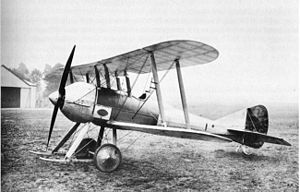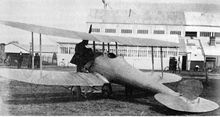Royal Aircraft Factory S.E.2 Video - Picture

|
|
Royal Aircraft Factory S.E.2
S.E.2

Picture - The S.E.2a at the Royal Aircraft Factory, Farnborough
Role: Scout aircraft
National origin: United Kingdom
Manufacturer: Royal Aircraft Factory
Designed by: Geoffrey de Havilland (B.S.1)
First flight: March 1913
Introduced: 1914
Retired: 1915
Primary user: Royal Flying Corps
Number built: 1
The Royal Aircraft Factory S.E.2 (Scout Experimental) was an early British single-seat scout aircraft. Designed and built at the Royal Aircraft Factory in 1913 as the B.S.1, the prototype was rebuilt several times before serving with the Royal Flying Corps, being operated over the Western Front in the early months of the First World War.
Development and design
In 1912, a team at the Royal Aircraft Factory, lead by Geoffrey de Havilland, started design of a single seat scout, or fast reconnaissance aircraft, the first aircraft in the world specifically designed for this role. The design was a small tractor biplane, and was named the B.S.1 (standing for Blériot Scout) after Louis Blériot, a pioneer of tractor configuration aircraft. It had a wooden monocoque circular section fuselage, and single-bay wings. Lateral control was by wing warping,while the aircraft was initially fitted with a small rudder without a fixed fin, and an all moving elevator. It was powered by a two-row, 14-cylinder Gnome rotary engine rated at 100 hp (75 kW).

Picture - The Royal Aircraft B.S.1 in its original form
The B.S.1 was first flown by Geoffrey de Havilland early in 1913, demonstrating excellent performance, with a maximum speed of 91.7 mph (147.6 km/h), a stalling speed of 51 mph (82 km/h) and a rate of climb of 900 ft/min (4.6 m/s), despite the engine only delivering about 82 hp (61 kW) instead of the promised 100 hp. However, on 27 March 1913, the aircraft crashed while being flown by de Havilland, breaking his jaw and damaging the aircraft.
Following this accident, it was repaired, with an 80 hp single-row Gnome and new tail surfaces, with triangular fins above and below the fuselage and a larger rudder. While the repaired aircraft was initially designated B.S.2, it was soon redesignated S.E.2 (for Scout Experimental). It was flown in this form by de Havilland in October 1913.
In April 1914, the S.E.2 was again rebuilt, this time under the supervision of Henry Folland, as de Havilland had left the Royal Aircraft Factory to become chief designer of Airco (the B.S.1/S.E.2 was the last design de Havilland produced for the Factory). The tail surfaces were again revised, with a larger fin and rudder, with new tailplane and elevators. The monocoque rear fuselage was replaced by conventional wood and fabric, and more streamlined struts and streamlined sectioned bracing wires (Raf-wires) were fitted. It was flown in this form on 3 October 1914. This modified version is often referred to as the "S.E.2a" - this designation was not used at the time, and was probably not official.
Operational history

Picture - The Royal Aircraft Factory S.E.2 in about October 1913 - after its reconstruction from the B.S.1 and before being rebuilt as the S.E.2a
The S.E.2 was handed over the Royal Flying Corps on 17 February 1914, with the serial number 609 being issued to No. 5 Squadron, where it made a good impression, and then to No. 3 Squadron before being returned to the Royal Aircraft Factory in April.
By the time the rebuilt "S.E.2a" version was completed, the First World War had broken out, and the modified S.E.2 was sent across the English Channel to join No. 3 Squadron on 27 October. It was fitted with an improvised armament of a pair of rifles mounted on the side of the fuselage, angled outwards to avoid the propeller, together with the pilot's revolver. It was one of the fastest aircraft available in the early months of the war, with it being said that:"Its speed enabled it to circle around the enemy machines and gave it a decided ascendancy." It remained in use with 3 Squadron until March 1915, when it was damaged by an exploding bomb and was sent back to England.
Operators
United Kingdom
Royal Flying Corps
No. 3 Squadron RFC
No. 5 Squadron RFC
Specifications (S.E.2)
Data from The Aeroplanes of the Royal Flying Corps (Military Wing)
General characteristics
Crew: 1
Length: 20 ft 10 in (6.35 m)
Wingspan: 27 ft 6¼ in (8.39 m)
Height: 9 ft 4â…› in (2.82 m)
Wing area: 188 sq ft (17.5m²)
Empty weight: 720 lb (327 kg)
Loaded weight: 1,132 lb (515 kg)
Powerplant: 1x— Gnome Rotary engine, 80 hp (60 kW)
Performance
Maximum speed: 91 mph (79 knots, 147 km/h)
Endurance: 3 hr
Armament
Guns: 2x— .303 in rifles
Comparable aircraft
Royal Aircraft Factory S.E.4
Bristol Scout
Sopwith Tabloid
Bibliography
Bruce, J.M. British Aeroplanes 1914-18. London: Putnam, 1957.
Bruce, J.M. The Aeroplanes of the Royal Flying Corps (Military Wing). London: Putnam, 1982. ISBN 0-370-30084-X.
Hare, Paul R. The Royal Aircraft Factory. London:Putnam, 1990. ISBN 0-85177-843-7.
Jackson, A.J. De Havilland Aircraft since 1909. London: Putnam, Third edition, 1987. ISBN 0-85177-802-X.
Mason, Francis K. The British Fighter since 1912. Annapolis, USA: Naval Institute Press, 1992. ISBN 1-55750-082-7.
Royal Aircraft Factory S.E.2 Pictures
Living Warbirds: The best warbirds DVD series.
Source: WikiPedia